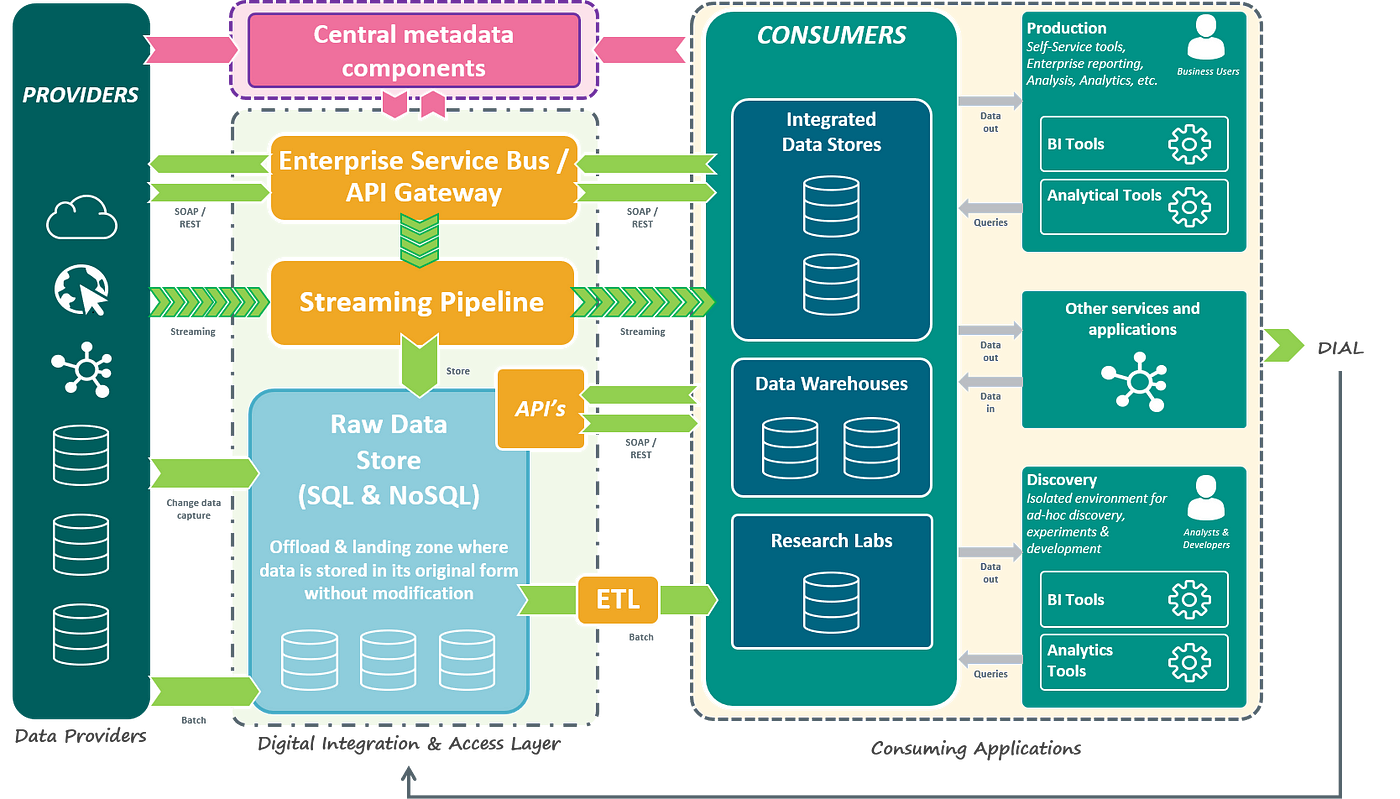P1]
In the data-driven world of today, information is the lifeblood of any successful organization. But data is often scattered across disparate systems, residing in silos that hinder collaboration, slow down decision-making, and ultimately limit potential. This is where data integration steps in – acting as the architect who designs and builds the bridges necessary to connect these islands of information, creating a unified and comprehensive view of the business landscape.
Data integration is more than just moving data from one place to another; it’s about transforming, combining, and presenting data in a way that’s meaningful and actionable for the users who need it. It’s about creating a single source of truth that empowers businesses to gain deeper insights, improve operational efficiency, and drive innovation.
What is Data Integration?
At its core, data integration is the process of combining data from different sources into a unified view. This can involve a variety of tasks, including:
- Data Extraction: Pulling data from various source systems, such as databases, cloud applications, spreadsheets, and even legacy systems.
- Data Transformation: Cleaning, standardizing, and transforming the extracted data to ensure consistency and compatibility. This includes activities like data cleansing, data enrichment, data mapping, and data aggregation.
- Data Loading: Loading the transformed data into a target system, such as a data warehouse, data lake, or a cloud-based platform.
The goal is to create a cohesive and consistent dataset that can be used for reporting, analytics, and other business intelligence purposes.

Why is Data Integration Important?
The importance of data integration stems from its ability to unlock the full potential of an organization’s data assets. Here are some key benefits:
- Improved Decision-Making: A unified view of data provides a comprehensive understanding of the business, enabling informed and data-driven decisions. Leaders can access accurate and timely information, leading to better strategic planning and execution.
- Enhanced Operational Efficiency: By automating data integration processes, organizations can reduce manual data entry, minimize errors, and streamline workflows. This frees up valuable time and resources, allowing employees to focus on more strategic initiatives.
- Better Customer Experience: Integrating customer data from various touchpoints, such as CRM systems, marketing automation platforms, and social media, provides a 360-degree view of the customer. This allows businesses to personalize interactions, improve customer service, and build stronger relationships.
- Increased Revenue Generation: By identifying trends and patterns in integrated data, organizations can uncover new revenue opportunities, optimize pricing strategies, and improve sales performance.
- Reduced Costs: Data integration can help organizations reduce costs by eliminating data redundancy, improving data quality, and streamlining reporting processes.
- Improved Compliance: Integrating data from various sources can help organizations comply with regulatory requirements and industry standards. This is particularly important in industries such as healthcare, finance, and government.
- Faster Time to Market: By providing a unified view of data, data integration can accelerate the development and launch of new products and services.


Different Approaches to Data Integration:
There are several different approaches to data integration, each with its own strengths and weaknesses. The best approach for a particular organization will depend on its specific needs and requirements. Some common approaches include:
- Manual Data Integration: This involves manually copying and pasting data from one system to another. This is a time-consuming and error-prone process, and it is not suitable for large volumes of data.
- Batch Processing: This involves extracting data from source systems at scheduled intervals, transforming it, and loading it into a target system. This is a common approach for data warehousing and business intelligence.
- Real-Time Data Integration: This involves integrating data in real-time as it is generated. This is a more complex approach, but it provides the most up-to-date view of the data. Common techniques include Change Data Capture (CDC) and message queuing.
- Data Virtualization: This approach allows users to access data from different sources without physically moving the data. Data virtualization creates a virtual layer that integrates data from different sources, allowing users to query the data as if it were in a single database.
- Extract, Transform, Load (ETL): ETL is a traditional data integration process that involves extracting data from source systems, transforming it, and loading it into a data warehouse or other target system. ETL tools are used to automate this process.
- Extract, Load, Transform (ELT): ELT is a more modern approach to data integration that involves extracting data from source systems, loading it into a data lake or cloud-based data warehouse, and then transforming it. This approach leverages the processing power of the data lake or cloud-based data warehouse to perform the transformations.
- Enterprise Service Bus (ESB): An ESB is a software architecture pattern used for integrating applications and services. It acts as a central communication hub, allowing different applications to exchange data and messages.
- API Integration: This involves using APIs (Application Programming Interfaces) to connect different applications and exchange data. APIs are a common way to integrate cloud-based applications and services.
Choosing the Right Data Integration Solution:
Selecting the right data integration solution is crucial for ensuring the success of any data integration project. Here are some key factors to consider:
- Business Requirements: What are the specific business needs that the data integration solution needs to address?
- Data Sources: What are the different data sources that need to be integrated?
- Data Volume: How much data needs to be integrated?
- Data Velocity: How frequently does the data need to be integrated?
- Data Variety: What are the different types of data that need to be integrated?
- Data Transformation Requirements: What types of data transformations are required?
- Scalability: Can the data integration solution scale to meet future needs?
- Security: Does the data integration solution provide adequate security?
- Cost: What is the total cost of ownership of the data integration solution?
- Ease of Use: How easy is the data integration solution to use and manage?
- Integration with Existing Systems: How well does the data integration solution integrate with existing systems?
The Future of Data Integration:
The field of data integration is constantly evolving, driven by factors such as the increasing volume and variety of data, the rise of cloud computing, and the growing demand for real-time insights. Some key trends in data integration include:
- Cloud-Based Data Integration: Cloud-based data integration solutions are becoming increasingly popular due to their scalability, flexibility, and cost-effectiveness.
- Self-Service Data Integration: Self-service data integration tools empower business users to integrate data without the need for IT support.
- AI-Powered Data Integration: Artificial intelligence (AI) is being used to automate data integration tasks, such as data mapping and data quality.
- Data Fabric: A data fabric is a unified data architecture that provides a single point of access to data from different sources.
- Real-Time Data Integration: The demand for real-time data integration is growing as businesses need to make decisions based on the most up-to-date information.
Conclusion:
Data integration is a critical component of any modern data strategy. By connecting disparate data sources and creating a unified view of information, organizations can unlock the full potential of their data assets, improve decision-making, enhance operational efficiency, and drive innovation. Choosing the right data integration approach and solution is essential for ensuring the success of any data integration project. As the field of data integration continues to evolve, organizations need to stay abreast of the latest trends and technologies to remain competitive in the data-driven world.
FAQ: Demystifying Data Integration
Q: What’s the difference between data integration and data warehousing?
A: Data integration is the broad process of combining data from various sources. Data warehousing is a specific application of data integration where the integrated data is stored in a centralized repository (the data warehouse) designed for reporting and analysis. Think of data integration as the umbrella, and data warehousing as one of the ways you can use that umbrella.
Q: Is data integration only for large enterprises?
A: No! While large enterprises with complex data landscapes often benefit significantly, data integration is valuable for any organization that relies on data from multiple sources. Even small businesses can leverage data integration to improve their understanding of customers, streamline operations, and make better decisions.
Q: How much does data integration cost?
A: The cost varies greatly depending on the complexity of the integration, the chosen tools, and the level of automation required. Options range from open-source tools to enterprise-grade platforms, each with its own pricing model. Consider factors like licensing fees, implementation costs, and ongoing maintenance when budgeting.
Q: What skills are needed for data integration?
A: Data integration requires a mix of technical and business skills. Key skills include:
- Data Modeling: Understanding data structures and relationships.
- ETL/ELT Development: Designing and implementing data pipelines.
- Database Administration: Managing and maintaining databases.
- Data Quality Management: Ensuring the accuracy and consistency of data.
- Business Analysis: Understanding business requirements and translating them into technical specifications.
- Programming: Knowledge of languages like Python, SQL, or Java can be beneficial.
Q: How do I ensure data quality during integration?
A: Data quality is paramount. Implement data quality checks throughout the integration process. This includes:
- Data Profiling: Analyzing the source data to identify inconsistencies and errors.
- Data Cleansing: Correcting or removing inaccurate or incomplete data.
- Data Validation: Verifying that the data meets predefined rules and standards.
- Data Monitoring: Continuously monitoring data quality to identify and address any issues.
Q: What are the challenges of data integration?
A: Data integration can be complex and challenging. Some common challenges include:
- Data Silos: Overcoming the isolation of data in different systems.
- Data Heterogeneity: Dealing with different data formats, structures, and semantics.
- Data Quality Issues: Ensuring the accuracy and consistency of data.
- Scalability: Managing large volumes of data.
- Security: Protecting sensitive data.
- Keeping up with evolving technologies: The data integration landscape is constantly changing.
Q: How long does a data integration project take?
A: The duration of a data integration project depends on the complexity of the integration, the number of data sources, and the chosen tools. Simple integrations can be completed in a few weeks, while more complex projects can take several months.
Q: What is Change Data Capture (CDC)?
A: Change Data Capture (CDC) is a technique used to identify and track changes made to data in a database. This allows for real-time or near real-time data integration by only replicating the changes, rather than the entire dataset. This is much more efficient than batch processing for applications that require up-to-date information.
Q: Is data integration only about technology?
A: Absolutely not. While technology is a crucial enabler, successful data integration requires a strong understanding of business processes, data governance policies, and organizational alignment. It’s a collaborative effort between IT and business stakeholders.

Leave a Reply